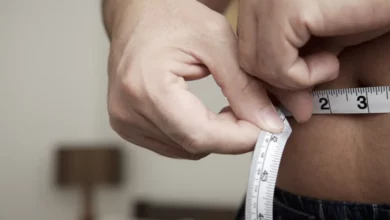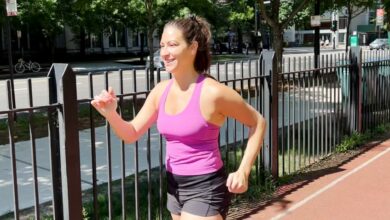As a certified fitness instructor, I often come across interesting fitness fallacies that clients and friends of mine wholeheartedly believe to be true. Although each fallacy may have some basic kernel of logic, often times these quick-fix fitness ideas are purely myth, and some can be highly detrimental to your health. In any case, I thought I would set a few things straight in an attempt to prevent the spread of fitness- related rumors.
1. Tracksuits burn fat on their own
Ali likes to run. He wakes up really early, puts on his tracksuit and running shoes, and off he goes to run around Maadi. “I believe the tracksuit helps me to lose weight,” says Ali with a smile, while I try to keep my distance from him and his sweaty tracksuit. “I believe the heat helps to burn all these layers of fat around my arms and belly.”
I hate to break it to Ali, but his tracksuit has nothing to do with his losing weight. The heat generated by the heavy tracksuit forces his body to release more water through sweat, which can only lead to serious dehydration and an unfavorable odor. The heat you feel when you work out is caused by the training of your muscles and is not related to an actual increase in temperature. So Ali, when you work out, try to wear cotton clothes that are both comfortable and well-ventilated, and drink water, lots of water.
2. Breakfast is a big no-no
Reham is not the “breakfast-type.” She runs to her office and saves her appetite for lunch time. “This way,” she says, eating a burger, “my metabolism will not have anything to work on during the day and it will start burning the fat in my body.”
Reham is nearly right, but not quite there yet. Your metabolism doesn’t automatically start burning fat the minute you open your eyes in the morning. It needs a kick-start for it to start burning the fat around your body. You need to eat a simple, easy-to-digest breakfast which gives you energy to start your day and fools your metabolism into thinking you have eaten a full meal. Your metabolism will actually burn the small meal you had, and then start burning some of the body fat you hope to lose.
3. A waist belt helps keep you trim
Liza is one of my clients who enjoys my morning step class. What she enjoys more, however, is wearing a waist belt while attending cardio classes. “It helps me lose inches from my waist,” says Liza, pointing to her slim figure. “I think it makes my exercise routine more challenging.”
Liza happens to be right. Exercise is more challenging when wearing the waist belt. What she doesn’t know, however, is that this is because it actually blocks her abdominal muscles from working properly and limits the blood flow to the whole area. The waist belt doesn’t force the different belly muscles to contract, but rather keeps them from moving at all. The inches Liza lost were not fat layers from the area around her belly, but muscle layers, dying one cell at a time.
4. Weight lifting beats cardio training
Hossam is one of those people who goes to the gym to buff his body up by lifting as much weight as he can handle, then returns home to bask in front of the mirror, flexing his muscles. “Cardio classes are not for me,” he says, training a bicep with a weight the size of my head, “and I hate cardio machines. Why would I lose time running on a treadmill when I can spend it doing push-ups?”
But what Hossam needs to understand is that, while he’s doing a great job for most of his muscles by weight-lifting, he is neglecting the most important muscle of all: the heart. The low intensity of weight lifting leaves little room for the heart to exercise along with the rest of the body muscles. Cardio training, on the other hand, is the kind of training that ensures a great workout for the heart and lungs together with the other muscles in the body. Not to mention, of course, the fat-burning element of cardio exercises.
5. You are so thin! Keep it up!
Salma knows I won’t lie to her. But funnily enough, she does not believe me when I tell her that being under her average weight is not good for her system. “But they talk about losing weight and looking like Kate Moss in all the fashion magazines and TV shows,” she says as she leaves yet another cardio class. “I don’t want to be overweight again. I’ve been there and it was not pretty.”
Fears of “gaining back the weight you lost” are valid and legitimate feelings, but being under your ideal body weight is more unhealthy. There is a certain balance between fat content and muscle percentage in the body and finding the right weight for you is an easy procedure. Ask for a fitness assessment next time you hit the gym, know your ideal weight, and stick to it. You will look good and be healthy. And besides, who doesn’t like the right curves in the right places?
6. One-item crash diets are successful
“I love crash diets,” says Marian, passing her shisha pipe to me. “When I feel I am starting to gain some weight I pick a fruit and Google its name along with the word “diet”. Most likely I will find myself a diet program online based on the healthy habit of eating fruits.” The latest fruit Marian picked for her diet was the banana, and she forced herself to eat bananas all day and everyday for two weeks. “I actually lost a lot of weight,” she says. “My body was forced to burn the fat to create certain nutritional elements that bananas don’t provide.”
The fact is, as much as the human body is complex and amazing, it can be really stupid. When you deprive your body of certain elements, the first thing it will do when you provide those elements again is store them immediately, in preparation for another bout of starvation. So basically, unless you are going to eat nothing but bananas for the rest of your life, this diet will simply not work.
7. Six-pack abs is the ultimate goal
Michael worked hard to gain his six-pack of abs. You can notice them curving under his tight polo-shirt. “I needed to work a lot on these muscles to be able to show them off,” he tells me in the gym reception while signing up for a “Killer Abs” class. “I’m so happy I accomplished my goal.”
Well, Michael will be sad to know that he still has some training to do. The muscle creating the abs look, known as the rectus abdominus, is actually divided into eight separated bands of muscles, rather than just six. The upper six are the ones giving Michael the six-pack look, but he still needs to develop two more bands of muscle–the lowest ones in his abdominal area–in order to avoid fat layers relocating there. Not that “just a six pack” is such a bad thing to have, right?
All the names in this article have been changed to save people from embarrassment.




